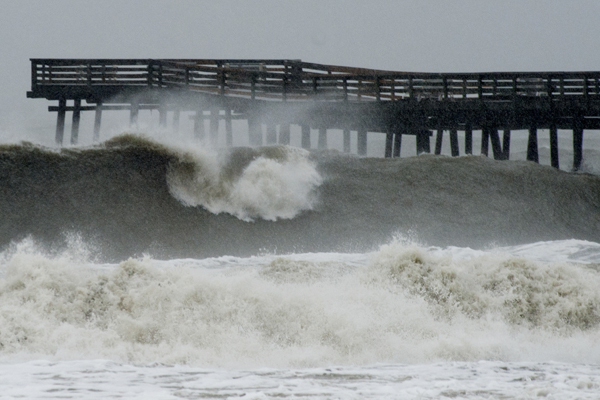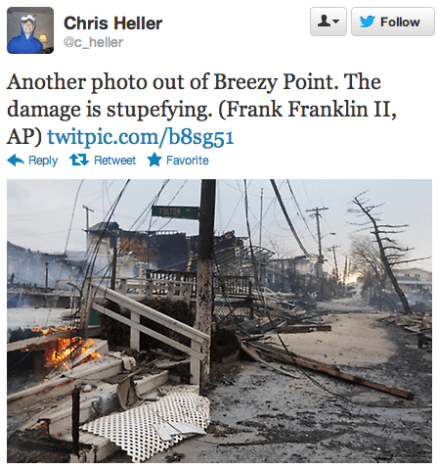The smartest thing we did when we got our apartment in Manhattan was the thing we thought about the least: We found a place on a hill. We watched Sandy hit New York in relative luxury. Working cable, internet, power, water. We were moderately, haphazardly prepared for the worst, but spared it. Many others were better prepared and fared far, far worse.

Hint.fmThe wind, at about 11 Eastern last night.
New York City feels like the epicenter of the storm not only because I live here, but because it’s a microcosm. It’s the largest city in the country, with skyscrapers and beach houses, tenements and suburbs. It’s a massive, centuries-old build-up of infrastructure and architecture, a city that’s not shy about its embrace of government. Sandy hitting New York was like Sandy hitting the diversity of America at its best prepared. And New York City got slammed.
A ConEd substation explodes on 14th Street, knocking out power in lower Manhattan.
Ten people were killed, with more fatalities likely. Three-quarters of a million people lost power in the city; it’s expected to be out for days. The subway system, as we feared might happen, got swamped. The Metropolitan Transit Authority’s chair noted, “The New York City subway system is 108 years old, but it has never faced a disaster as devastating as what we experienced last night.” Every single subway tunnel running under the East River was flooded; a car tunnel between Manhattan and Brooklyn was completely filled with water. A massive fire on Breezy Point, at the isolated tip of the island that runs along southern Brooklyn, burned more than 80 houses.
Watching the news and tracking Twitter last night, an obvious analogy kept cropping up, always with qualifiers: Sept. 11. The shock, surprise, damage, fear, confusion all echoed the attacks on that day. The stock exchanges are closed for a second day for the first time since 9/11. The bridges and tunnels connecting Manhattan to New Jersey and the other boroughs were shut down, as they were on that day. The damage to New York will almost certainly result in fewer deaths, but possibly broader local economic impact; Businessweek suggesting the damage could total more than $20 billion.
The day after Sept. 11, President Bush stood on the rubble and pledged to fight the cause of the damage. Having dismissed warnings that such a scenario was possible, Bush swore that he wouldn’t allow it to happen again. It is unlikely we’ll see a similar commitment after Sandy. On Sept. 11, 2012, the Times noted that the city has been slow to respond to the threat of rising sea levels. But there’s no indication that President Obama — or any other elected official — will use this moment, that warning coming to fruition, to launch a long, expensive war against climate change, to push through important legislation aimed at lessening future disasters. The 9/11 Memorial, it’s worth noting, was flooded by Sandy.
Gov: As I said to the President yesteray, we have a 100-yr flood every 2 yrs #sandy
— Andrew Cuomo (@NYGovCuomo) October 30, 2012
“Anyone who says there is not a dramatic change in weather patterns is denying reality” – Cuomo
— Ed Crooks (@Ed_Crooks) October 30, 2012
Reports will continue to trickle in over the next day or two detailing the damage done to New York and New Jersey and the rest of the Eastern seaboard. There will be more announced deaths. It will be days, maybe a week, before power is completely restored.
For New York residents, one of the best defenses against yesterday’s storm was elevation. That’s not a solution that’s scalable, nor is it one that will work for the rest of the East Coast — or the West Coast, or the world.
We need to come up with another plan of action.
Emergency vehicles, stranded in flooded streets, nothing to do. Then, just as the video ends, the lights blink out.





